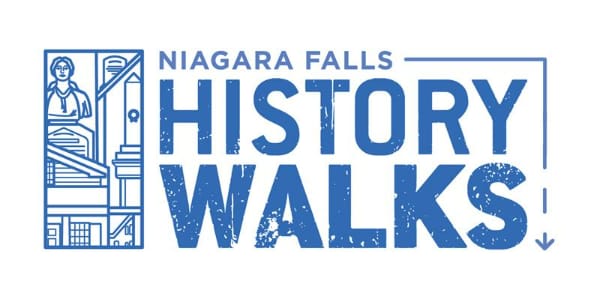
History Walks
![history walks logo]() Enjoy a 90-minute walking tour of two of Niagara Falls' most iconic historical points of interest -- Drummond Hill Cemetery & the Battle Ground Hotel Museum -- located just steps from the Niagara Falls History Museum
Enjoy a 90-minute walking tour of two of Niagara Falls' most iconic historical points of interest -- Drummond Hill Cemetery & the Battle Ground Hotel Museum -- located just steps from the Niagara Falls History Museum
**Please note: walking tours are seasonal and will return in summer 2024**
ABOUT THE WALKING TOUR
Begin your walking tour at the Niagara Falls History Museum, taking a short stroll to the Drummond Hill Cemetery, a Nationally recognized heritage site. The guided tour will explore graves and monuments connected to the War of 1812, the Underground Railroad, a Niagara Falls daredevil, and Canadian heroine, Laura Secord.
Designated a National Historic Site of Canada in 1937, the Drummond Hill Cemetery stands on the hallowed ground of the Battle of Lundy’s Lane, the bloodiest battle of the War of 1812.
Before returning to the Niagara Falls History Museum, the 90-minute experience is wrapped up with a guided tour of the Battle Ground Hotel Museum. Built in 1831, and restored to 1855, you’ll uncover stories of early Niagara tourism and 19th century tavern life.
ABOUT DRUMOND HILL CEMETERY
Drummond Hill Cemetery is a nationally recognized heritage site. It is most famously known as the battle grounds of the "Battle of Lundy's Lane" during the War of 1812. Christopher Buchner purchased 400 acres of land from his father-in-law, James Forsythe, in 1799 and used the top of the hill as a burial ground. It later became the site of a fierce battle between the British and the Americans in 1814. The area became known as Drummond Hill, in honour of British General Sir Gordon Drummond.

DRUMMOND HILL CEMETERY HIGHLIGHTS
Battle of Lundy’s Lane
The Battle of Lundy’s Lane was a turning point in the War of 1812-14. While British reinforcements began arriving in North America following the defeat of Napoleon in Europe, the Americans were pushing to gain control of the Niagara Peninsula with hopes of moving on to York (now Toronto), Kingston and Montreal. Their attempts were thwarted at the Battle of Lundy’s Lane, which stopped the American advance and marked the beginning of the end of the war.
The cemetery was the focal point of the battle, and the Battle of Lundy’s Lane Memorial is the most pronounced marker on the field. The beautiful Copper Beech Tree is another feature of the property, along with memorials and gravestones of various Canadian and American soldiers who fought in the Battle of Lundy’s Lane.
Laura Secord
One of Canada’s favourite heroines, overheard Americans plans to attack British at Beaver Dams. Laura made a harrowing 32 km trek through a warzone, to warn the British of the impending attack. Taking advantage of Laura's information, Lt. FitzGibbon, along with 50 soldiers and Indian reinforcements, ambushed American soldiers near Beaver Dams on the morning of June 24, and tricked 462 American soldiers into surrendering. The victory at Beaver Dams was an important turning point for the British and helped them to regain control of the Niagara frontier.
Burr Plato
One of the outstanding citizens of early Niagara Falls was Burr Plato. Plato was born into enslavement in West Virginia in 1833. At the age of twenty-three he decided to escape to freedom. Along with seven other enslaved individuals he made his way along the network of secret routes and safe houses of the so called Underground Railway to Fort Erie Ontario. As an enslaved person he had no possibility of an education, but he believed that literacy was the only sure way to success. He settled in Niagara Falls and worked as a farmhand and porter while he learned to read and write. He ran for councilman in 1886, in what was then the Village of Niagara Falls. Plato was one of the first African-Canadian persons in Canada elected to political office and he held the position until he died in 1905 at the age of 72.
And more...!
ABOUT THE Battle Ground Hotel
A guided tour at the Battleground Hotel Museum will transport you back to 1850’s tavern life in the quaint town of historic Drummondville. This small town thrived from its proximity to the falls and its location on one of the bloodiest battles fought on Canadian soil. The tavern remains as one of the earliest examples of Niagara Falls tourism as many tourists came to see the battlefield of Lundy’s Lane.
FAQs
- CANCELLATION DUE TO WEATHER. This is a RAIN OR SHINE event. We reserve the unilateral right to cancel due to adverse weather conditions (lightning, torrential rains, high winds, etc.) or other emergency.
- Tour begins and ends at the Niagara Falls History Museum
- The tour is approximately 90 minutes and 2 kilometres (1.2 miles) of walking
- A portion of the walking tour is uphill, wear comfortable footwear
- The tour is unfortunately not accessibility friendly
- Space is limited
- Tickets include regular admission to the Niagara Falls History Museum
- No refunds

